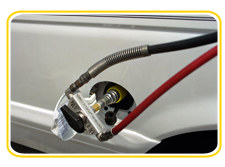 Burning natural gas results in lower emissions of sulfur dioxide, particulate matter, and 20% less carbon dioxide than gasoline or diesel. It is one of the cleanest burning fuels. Natural gas is non-toxic, non-corrosive, less combustible than most other fuels, and has few associated health risks. CNG is stored under high pressures. The range of flammability and combustion is much narrower with CNG, making it safer than gasoline. The flashpoint for gasoline is 250 degrees whereas the flashpoint for natural gas is 1100 degrees. Natural gas is lighter than air and will dissipate if leaked whereas gasoline will sink and puddle. Dedicated NGVs produce little or no evaporative emissions during fueling and use. In gasoline vehicles, evaporative and fueling emissions account for at least 50% of a vehicle's total hydrocarbon emissions. Burning natural gas results in lower emissions of sulfur dioxide, particulate matter, and 20% less carbon dioxide than gasoline or diesel. It is one of the cleanest burning fuels. Natural gas is non-toxic, non-corrosive, less combustible than most other fuels, and has few associated health risks. CNG is stored under high pressures. The range of flammability and combustion is much narrower with CNG, making it safer than gasoline. The flashpoint for gasoline is 250 degrees whereas the flashpoint for natural gas is 1100 degrees. Natural gas is lighter than air and will dissipate if leaked whereas gasoline will sink and puddle. Dedicated NGVs produce little or no evaporative emissions during fueling and use. In gasoline vehicles, evaporative and fueling emissions account for at least 50% of a vehicle's total hydrocarbon emissions.
Exposure to the levels of suspended fine particulate matter found in many U.S. cities has been shown to increase the risk of respiratory illness and other health problems. Much of the particulate matter in urban areas is due to transportation. Natural gas produces only tiny amounts of particulate matter. Natural gas is abundant, low-cost, and domestically produced.
CNG reduces:
- Benzene emissions by 97% compared to diesel and 99% compared to gasoline
- Nitrogen oxides by 87% compared to diesel and 35-60% compared to gasoline
- Carbon dioxide by 10% compared to diesel and 25% compared to gasoline
- Carbon monoxide by 90-97% compared to gasoline
- Non-methane hydrocarbons by 50-75% compared to gasoline
- Lead and sulfur emissions by 100% compared to both diesel and gasoline
- Smoke and particulate matter (PM10) significantly
|


